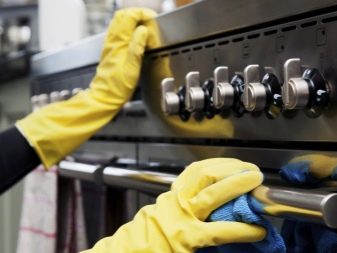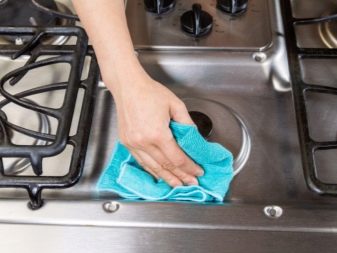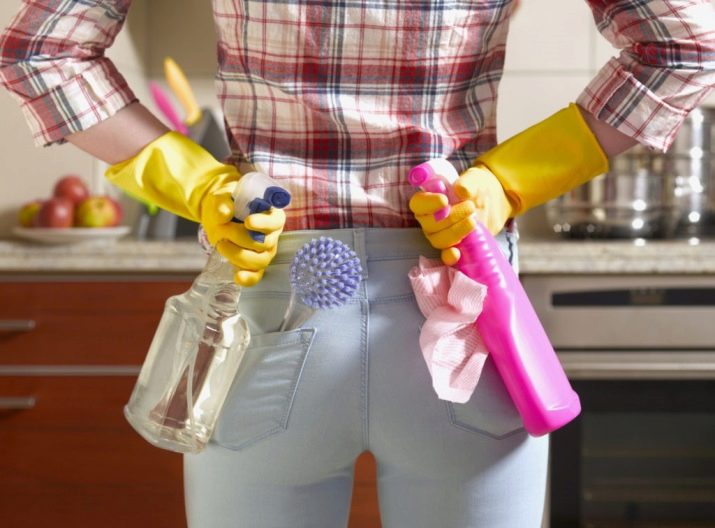How to clean the stove from grease and other contaminants?

The stove is an indispensable attribute of every kitchen. During cooking, greasy stains form on its surface, which is not always possible to eliminate immediately. Over time, carbon deposits form, which is very difficult to deal with without the use of detergents.

Cleaning rules
Cleaning the surface and contaminated grate of the gas stove can only be done after disconnecting the device from the gas supply. Safety rules should always be followed.
Just one step to disconnect the device from the gas supply will eliminate the possibility of accidental gas supply, as well as protect you from possible injury.
Next, you should carefully remove the grate from the gas stove. Very often it is she who is the most contaminated. The grate usually accumulates a lot of fat, which is the most difficult to eliminate.
To clean the grate, you can use traditional methods that have already been tested by time. Many housewives have become convinced of their effectiveness. The wire rack should be placed in a tub or basin filled with hot water and laundry soap. To prepare the grill cleaning solution, you need to take 5 liters of water and one bar of 72% soap. It is necessary to select such a container so that the grate is completely immersed in the prepared solution.


A gas stove must have burners and electric ignition. They are also subject to accumulation of dirt and grease.If these elements are removable, then they should be removed from the stove and also immersed in a soapy solution for high-quality cleaning.
Soak contaminated elements for a few days. After this procedure, the washing of grease and dirt will be easier.
Special cleaning agents are required to clean pens and hard-to-reach areas. If the gas stove is equipped with an oven, then it is imperative to clean its outer surfaces and internal parts.


Funds
Both folk remedies and special detergents purchased in stores will help to eliminate fat and various kinds of pollution. Traditional methods are less effective and require more time and effort to thoroughly clean the gas stove. When using household chemicals you should be very careful in terms of safety so that it does not get into food in the future.

Folk
If desired, you can use your own products to remove grease from the gas stove. Traditional methods are chosen by those who prefer safe and proven methods and do not like to use synthetic household chemicals.
Everyone can clean the stove with folk remedies, since all the components are always at hand. Household chemicals are not in demand, because they can cause allergies, are unsafe to use, and all actions must be carried out with rubber gloves to protect the skin of the hands from various kinds of damage.

Household chemicals
Modern manufacturers of household chemicals offer a wide range of products that allow you to quickly and easily remove even difficult to remove dirt and a large layer of grease.
All cleaning products can be divided into three groups:
- Abrasive the funds are presented in the form of powders containing abrasive particles. They have a wide price range. They must be evenly applied to the surface of the plate and left for 30 minutes, then, using a brush or napkin, he cleans the surface. Next, you need to thoroughly wash it before removing the detergent. This option is ideal for removing stains from stainless steel surfaces and is strictly prohibited for enamelled slabs.
- Detergents funds are represented by gels, creams, foams and pastes. Gels and creams include microbeads that act like an abrasive but are very mild and also have a pleasant scent. They should be applied to a wet surface and wait half an hour to dissolve any kind of contamination. Foam or paste is ideal for cleaning vertical surfaces and is effective and gentle. Paste is a more economical option than foam.
- Fat solvents made in the form of sprays. They are ideal for cleaning the lids and grills. Spray the agent on contaminated elements, leave for a certain time specified by the manufacturer, and rinse with water. Cleaning should only be done with gloves. It is worth paying attention to the composition of the spray, since some are designed specifically to remove carbon deposits, so it is quite difficult to wash off.


Remove grease and burnt stain
To eliminate greasy and burnt spots, it is necessary to make preliminary preparation. Use hot water and baking soda to soften stubborn stains. The surface of the stove must be moistened with hot water and sprinkled with soda. After half an hour, you can start cleaning the surface from grease and burnt spots.
To remove soda, you should give preference soft sponge... Experts do not recommend using metal scouring pads. For hard-to-reach areas, you can use an old toothbrush or cotton swabs.
This cleaning option can be used for the stove and oven. The inner walls are best cleaned with a soapy solution, which you can make yourself.


An excellent remedy for removing burnt spots is the use of solutions with the addition of citric acid, juice or vinegar essence... These funds can be used both separately and together. A great solution is a combination of vinegar and ammonia solution. It is strong and effective in combating burnt spots and thick layers of grease.
The choice of product depends largely on the surface to be cleaned. Some products are gentle, while others are very powerful, so they will only work on some surfaces.

On glass
Many modern hobs have a glass-ceramic hob that requires gentle maintenance. The surface of the slab must be moistened with a soft sponge.
Creamy products should be used as they are mild.
The agent must be applied to the surface and wait a little. If dirt remains after wiping the surface, you can use a special scraper. This tool will allow you to easily remove burnt residues. After removing dirt, the glass surface should be wiped with a clean sponge, and then again with a soft towel.

Baking soda can be used to combat stubborn stains. It is safe for glass, therefore it is in demand. It is necessary to moisten a little soda before use, and then treat dried spots with it and leave for a few minutes. After that, the surface of the stove must be washed with water, removing all soda residues.
You can add one more drop of lemon juice or vinegar to enhance the baking soda. The interaction of these substances helps to quickly cope with heavy carbon deposits.
To eliminate stains on glass, you can use not only traditional methods, but also chemical creams and liquids. But you should be careful when choosing household chemicals, since some products contain strong alkalis and acids, which can negatively affect the glass surface.
Before using a particular product, you must read the manufacturer's instructions. All actions must be performed with rubber gloves.
Another way to remove stains on a glass surface is melamine sponge. It needs to be moistened with water and wiped off the dirty areas on the surface. After cleaning, rinse the panel with water and dry it with a dry towel.


On the electric stove
All heating elements in the metal case cannot be disassembled, so this stove is distinguished by the accumulation of fat around the burners. To quickly clean an electric stove at home, you need to perform a certain series of actions:
- Wait until all heating elements on the hob have cooled down.
- Remember that the electric stove must be disconnected from the power supply. Safety measures must come first.
- The cleaning agent must be carefully applied to the surface, wait for the fat to dissolve and wipe the coating with damp wipes.
You can use a wood skewer or toothpick to thoroughly remove greasy and burnt spots around the heating parts.
It is strictly forbidden to pour water on the surface of the electric stove, since even a slight ingress of water on the spirals can cause a short circuit.

On metal
Many modern hobs have a stainless steel hob. Such a gas stove looks spectacular and beautiful in the kitchen. But even minor streaks and stains are very noticeable on the stainless steel surface.
To wash the metal surface from old grease, you must adhere to the following rules:
- Any contamination must be removed from the surface immediately. There is no need to wait for a burnt stain to form.
- To remove dirt, you will need a sponge and any grease or dishwashing detergent.
- A soda-soap solution will help to clean the metal hob. It must be applied to dirt, leave for half an hour and rinse thoroughly with water.

On ceramics
For stubborn stains on ceramic surfaces, you can use a scraper or a plastic spoon to clean stubborn stains. They can help you get rid of both fat and burnt spots, but the steps must be done carefully and slowly.
When using a spoon, it should be kept at an inclination of 30 degrees. If force is applied, the ceramic coating may be scratched. Stain residues can be easily removed using detergent and a soft sponge.
To remove heavy carbon deposits, you can use another method. You need to take olive oil and pour a few drops on the stain, then leave for 20 minutes. Thanks to the use of oil, cleaning the surface will be much easier.


If the above tools and means are not at hand, then with fat lemon juice, vinegar and soda will help to cope. To make a cleanser, take baking soda and mix with a little water until it looks mushy. Apply the resulting product to stains and leave for 20 minutes.
Care must be taken to ensure that the baking soda does not dry out on the surface, as this can damage the ceramic coating. After 20 minutes, remove the baking soda with a damp cloth.
If you use vinegar, then it must be mixed with water in equal proportions. Use this product to gently wipe the stain. Vinegar has not only cleansing but also disinfecting properties. After its application, no streaks remain on the ceramics.

Removing carbon deposits from the grate
The hardest part of the hob is the grate, as it is on this that a thick layer of fat accumulates. When choosing a method for cleaning it, it is necessary to build on the fact that what material is it made of:
- The cast iron grate must be calcined. To do this, you can use an oven, gas stove or blowtorch. Use a metal sponge to thoroughly clean the rods.
- You can use a dishwasher to clean stainless steel or enamelled grids. It is necessary to select a program using high temperature water.
If there is no dishwasher, the wire rack should be dipped in a container with hot water, after adding a small amount of detergent. To prepare the solution, you will need soap, vinegar and soda. The product must be soaked for 12 hours in order for the fat to soak well. After that, the dirt must be removed with an iron brush.


Effective cleaning methods for heavily soiled wire mesh:
- Warm sand removes various contaminants, but the cleaning process takes a long time.
- Dry mustard is applied to the rods, left on for several hours, and then washed off with water.
- Car engine cleaner does an excellent job of removing grease. After using it, rinse the grate thoroughly.

How do I clean the cooking zones?
Not only the outer surface of the stove needs cleaning, but also the burner. It consists of three parts: a protective cover, a flame diffuser and a nozzle or jet. Not everyone can do a complete burner cleaning.
First you need to disassemble the burner, remove all parts for thorough cleaning. The hotplates are easy to clean using a toothbrush and soap solution.
Burners are usually made of aluminum, therefore acid and chlorine free options should be used when choosing a cleaning agent. It is strictly forbidden to use soaking.
Be sure to turn off the gas supply to clean the injector. If the holes are clogged with food debris or grease, then metal wire can be used. You can do this procedure yourself or call a specialist.


How to clean the pens?
Gas stove handles always accumulate a large amount of grease. Usually, dirt accumulates in the most inaccessible places, so cleaning them should be discussed in more detail.
Removing the handles is ideal. This must be done according to the instructions for the gas stove. If the handles can be removed, then you can use the same methods for cleaning them as for the grate. It is necessary to collect water in a container and dissolve laundry soap in it. Handles should be soaked for half an hour to facilitate cleaning.
Another option - per liter of water, you will need 2 tbsp. tablespoons of vinegar essence. For this method, it is imperative to wear gloves to reliably protect the skin of the hands. Pens should be placed in the prepared solution and put on fire. You need to boil them for about 5 minutes, then drain the solution and wait for them to dry naturally.

If the handles cannot be removed from the stove, then it is worth using cotton swabs, toothpicks, and an old toothbrush. For easy removal of dirt, it is worth using ammonia or soda ash or baking soda. First you need to moisten the surface and sprinkle with baking soda. This is sufficient to remove fat. But if this does not help to eliminate strong pollution, then you can use cotton swabs and ammonia.

How do I clean the oven?
You can use tools at your disposal to clean the oven. With their help, you must first prepare a solution for cleaning the ovens inside. You can use the same methods as for cleaning the burners.
For cleaning internal surfaces, you should give preference soapy water. Use a sponge to treat all surfaces and leave for 20 minutes. This will make it easy to clean a very dirty oven.
To clean the baking sheet and internal parts, you can pour the soapy solution into the baking sheet and turn on the oven for half an hour at a temperature of 120 degrees. Next, you need to gently wipe all parts with a soft sponge.

You can use citric acid or baking soda. It is necessary to dissolve one of the agents in water and process the walls of the oven, leave the agent for 25 minutes, then wipe with paper and rinse with water.
To remove minor contaminants, a solution made from water and vinegar is suitable. You should turn on the oven for 15 minutes, setting the temperature to 50 degrees. Softened dirt is perfectly removed with a sponge.

How to wipe off plastic and foil?
Plates are a source of danger as they heat up to very high temperatures. Hot tiles are capable of melting plastic.
It is best to keep plastic utensils away from gas and electric stoves. If plastic or foil has already adhered to the product, then it is worth taking action to eliminate contamination.

For cleaning enamelled or stainless steel hobs you will need to do the following:
- Ventilate the area immediately as molten plastic is hazardous to health.
- Wait for the plastic to cool completely.
- Remove dirt with a mild knife as much as possible.
- Treat the contaminated area with WD-40 multipurpose grease and leave for 5 minutes.
- Gently wash off the grease with soapy water and dry thoroughly.
- Remaining plastic can be removed with nail polish remover, but first test this tool on a small area.
You can remove plastic and foil from the stove using baking soda. It is necessary to make a paste from baking soda and water. Treat contaminated areas with paste. Do not rub the surface very hard so as not to scratch it.

Care Tips
So that the plate does not lose its original appearance, and also does not form a greasy coating on it, you must adhere to a few simple rules:
- To avoid problems with stubborn grease, it is necessary to clean the stove every time after use.
- Chemical cleaning of hobs must be carried out exclusively with gloves.
- When cleaning the hob, thoroughly wipe the entire surface, not just the hotplates, as the fat is evenly distributed over the entire hob.
- It is worth excluding the use of metal brushes, hard sponges or scrapers when cleaning the oven. They can cause scratches.
- You can quickly remove grease with a steam cleaner. After five minutes, all dirt can be removed using only a damp cloth.

For information on how to wash the stove from fat with folk remedies, see the next video.








